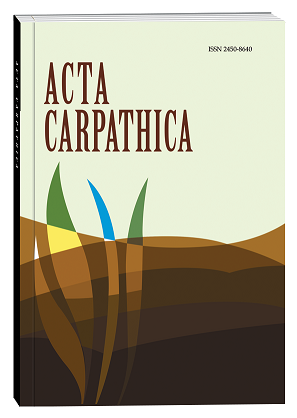PREVALENCE OF INVASIVE SPECIES IN DROHOBYCH DISTRICT AND THEIR IMPACT ON BIODIVERSITY
DOI:
https://doi.org/10.32782/2450-8640.2022.2.5Keywords:
invasive plants, biodiversity of Drohobych district, naturalization of invasive species, bioecological characteristicsAbstract
The spread of invasive plants in the eastern part of Drohobych district in the vicinity of the villages of Nove Selo, Ranevychi, Verkhni Gai, Nyzhni Gai, Biynychi, Dalyava, Pochaevychi, Bolekhivtsi was studied. 38 species of invasive plants belonging to 21 families and 35 genera were identified in the study areas of the Drohobych district. It was found that the Asteraceae family has the largest number of species – 11, which is 29,3% of the total number of species. Poaceae and Fabaceae have 3 species each (7,9%); Apiaceae, Convolvulus, and Balsaminaceae have 2 species each (5,3%); the remaining 15 families are represented by one species, which is 2.6%. Among the identified plant species of the Drohobych district, endophytes dominate by the time of introduction – 25 species (65,8% of the total number of invasive species), archeophytes have 13 species (34,2%). The species of North American origin (16 species – 42,2%); Mediterranean (7 species – 18,4%); Mediterranean-Iranian-Turanian (4 species – 10,5%) and Asian (3–7,9%) origin predominate. East Asian and Caucasian habitats have 2 species each (5,3%), and other primary habitats are represented by 1 representative (2,6%). Agri-epicophytes (16 species – 42,1%) and epicophytes (15 species – 39,4%) dominate by the degree of naturalization. Agriophytes are represented by 3 species – 7,9%; ergasiophytes and ephemerophytes numer 2 species, which are 5,3%. The majority of invasive plant species of Drohobych district overcame the E-barrier – 23 species (60,5%). The number of species overcoming the F-barrier is less than 15 species (39,5%). According to the hygromorph, mesophytes predominate – 22 species (57,9%), xeromesophytes, which are represented by 14 species (36,8%), possess second place; mesoxerophytes number 2 species (5,3%). Thus, alien plant species displace native species, occupying more and more new territories, which results in irreparable losses among the species of autochthonous flora. The spread of invasive plants affects not only the nature of vegetation but also the biogeochemical characteristics of landscapes. This reduces the economic and commercial value of the land. We consider it advisable to conduct further monitoring of the state of the invasive species spread and their impact on native plant groups.
References
Мінарченко В.М. Звіт про науково-дослідну роботу «Ведення державного кадастру рослинного світу». Київ, 2018. 507 с.
Протопопова В.В., Шевера М.В. Інвазійні види у флорі України. І. Група високоактивних видів. GEO&BIO. 2019. Vol. 1. Р. 113–135.
Інвазійні рослини в урбоекосистемі Львова / З.І. Мамчур та ін. VI-й Всеукраїнський з’їзд екологів із міжнародною участю. Львів, 2017. С. 137.
Малиновський А.К. Основні напрями та результати досліджень фітоінвазій. Наукові записки Державного природознавчого музею. Львів, 2018. Вип. 34. С. 55–68.
Павлишак Я.Я., Гойванович Н.К. Синантропна флора Передкарпаття (Дрогобицький район) та її аналіз. Науковий вісник Національного лісотехнічного університету України. 2017. С. 38–41.
Обґрунтування «чорного списку» загрозливих для біорізноманіття інвазійних видів рослин України / O.C. Абдулоєва та ін. Вісник Київського національного університету. Серія «Біологія». 2008. Вип. 52–53. С. 106–107.
Нечитайло В.А., Кучерява Л.Ф. Ботаніка. Вищі рослини. Київ : Фітосоціоцентр, 2005. 432 с.
Морозюк С.С., Протопопова В.В. Трав’янисті рослини України. Атлас-визначник. Тернопіль : Навчальна книга – Богдан, 2007. 216 с.
Протопопова В.В., Шевера М.В. Фітоінвазії. ІІ. Аналіз основних класифікацій, схем і моделей. Промышленная ботаника. 2012. Вип. 12. С. 88–95.
Екофлора України / Я.П. Дідух та ін. Київ : Фітосоціоцентр, 2000. 284 с.
Assessment of existing lists of invasive alien species for Europe, with particular focus on species entering Europe through trade, and proposed responses. Draft. Prepared by mr Piero Genovesi and mr Riccardo Scalera. Convention on the conservation of European wildlife and natural habitats (t-pvs/inf (2007).
EPPO (European and Mediterranean Plant Protection Organization). Lists of Invasive Alien Plants. URL: https://www.eppo.int/ACTIVITIES/invasive_alien_plants/iap_lists.








